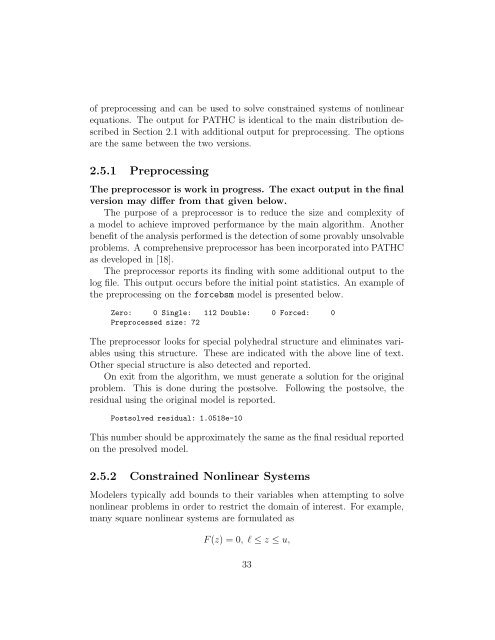GAMS/PATH User Guide Version 4.3
GAMS/PATH User Guide Version 4.3
GAMS/PATH User Guide Version 4.3
Create successful ePaper yourself
Turn your PDF publications into a flip-book with our unique Google optimized e-Paper software.
of preprocessing and can be used to solve constrained systems of nonlinear<br />
equations. The output for <strong>PATH</strong>C is identical to the main distribution described<br />
in Section 2.1 with additional output for preprocessing. The options<br />
are the same between the two versions.<br />
2.5.1 Preprocessing<br />
The preprocessor is work in progress. The exact output in the final<br />
version may differ from that given below.<br />
The purpose of a preprocessor is to reduce the size and complexity of<br />
a model to achieve improved performance by the main algorithm. Another<br />
benefit of the analysis performed is the detection of some provably unsolvable<br />
problems. A comprehensive preprocessor has been incorporated into <strong>PATH</strong>C<br />
as developed in [18].<br />
The preprocessor reports its finding with some additional output to the<br />
log file. This output occurs before the initial point statistics. An example of<br />
the preprocessing on the forcebsm model is presented below.<br />
Zero: 0 Single: 112 Double: 0 Forced: 0<br />
Preprocessed size: 72<br />
The preprocessor looks for special polyhedral structure and eliminates variables<br />
using this structure. These are indicated with the above line of text.<br />
Other special structure is also detected and reported.<br />
On exit from the algorithm, we must generate a solution for the original<br />
problem. This is done during the postsolve. Following the postsolve, the<br />
residual using the original model is reported.<br />
Postsolved residual: 1.0518e-10<br />
This number should be approximately the same as the final residual reported<br />
on the presolved model.<br />
2.5.2 Constrained Nonlinear Systems<br />
Modelers typically add bounds to their variables when attempting to solve<br />
nonlinear problems in order to restrict the domain of interest. For example,<br />
many square nonlinear systems are formulated as<br />
F (z) =0,ℓ≤ z ≤ u,<br />
33

















